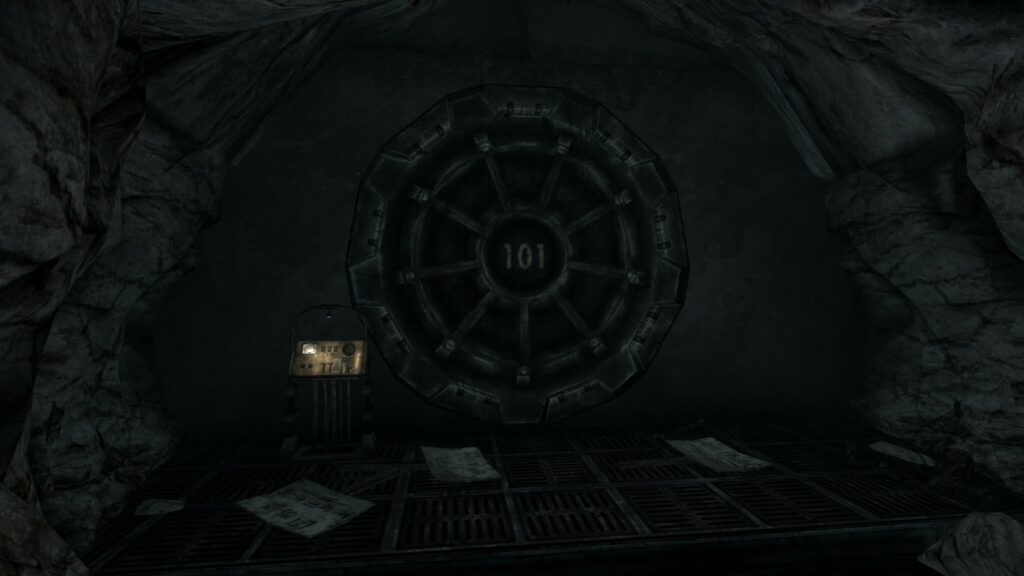
So let’s take a quick look at some of the logical social experiments conducted in the non-Bethesda Vaults, starting with Fallout 1.
Vault 13:
The starting point for all things Fallout, this is the Vault the player is kicked out of in the first game in order to search for a water purifier chip. The experiment here was prolonged isolation. The only reason it was unsealed is because the water chip broke, and their supply of chips was accidentally sent to Vault 8 instead.
(There’s minor conflicting info here from two different sources—Chris Avellone and Dick Richardson—that say it was a prolonged isolation experiment, or ‘was a Control Vault designed to stay sealed until it was needed’ respectively, but either way the basic premise is the same: it was meant to stay sealed.)
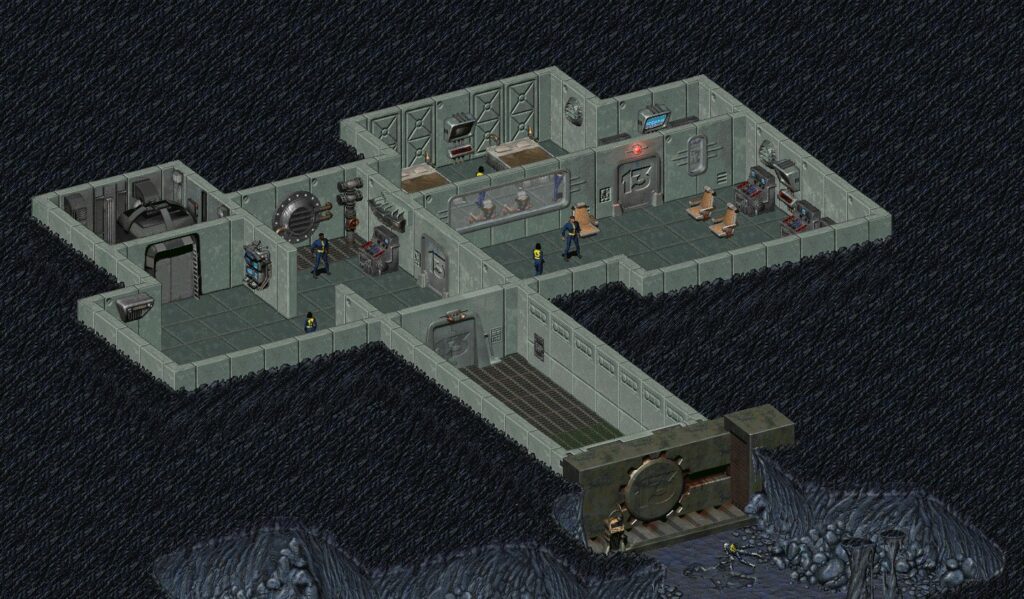
Vault 12:
Designed intentionally so that the Vault door wouldn’t close properly in order to test effects of long-term radiation. Probably pretty important information when dealing with space, where there’s a constant level of radiation and no natural shielding. This Vault became Necropolis, the city of ghouls, as a result.
It’s true that this one isn’t actually a social experiment. What it is instead is an important experiment in how radiation effects humans over extended periods of time, again with a random population sample. It’s in no way crazy science wackiness, plus I’m happy to accept a slightly different Vault in this instance because it leads to a really interesting story and decisions for the player.
Vault 15:
The effects of putting a multi-racial / multi-ethnic populace into close confinement together. This one was a resounding success, with everyone basically getting along great. A cave-in forced the eventual evacuation of the Vault, followed by a schism… which went on to produce three of the nastiest raider gangs (Khans, Vipers, Jackals), plus the community of Shady Sands. Just goes to show that when people are freed from social constraints, they can turn nasty real fast. We’re seeing that in the real world right now :/
Now for Fallout 2.
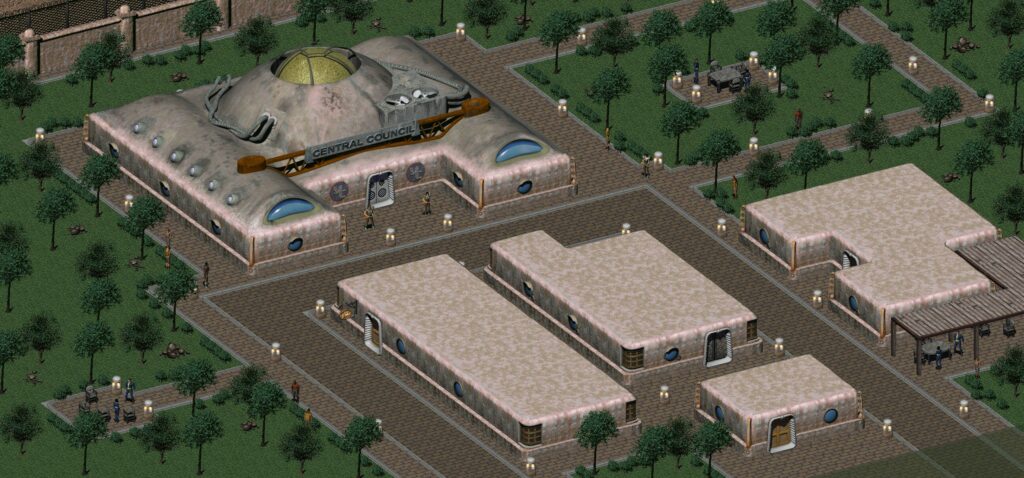
Vault 8:
This was a Control Vault, meaning no experiment. It was left to its own devices, had a set timetable (10 years, then open, though really it was meant to be 20, and this mistake left some of the population sterile, oops), and was a resounding success in that it became the large Vault City settlement. Of course, things did go downhill pretty quickly as they turned in on themselves and became kind of self-indulgent, elitist pricks. But hey, no one’s perfect.
More important is the fact they succeeded and prospered, and are pretty much the most high-tech and self-reliant faction in Fallout 2’s world, an important achievement when one considers the challenges colonisers would face on other worlds. They just need to work on that whole authoritarian, massively elitist asshole worldview, no biggie.
Next up, New Vegas.
Vault 3:
Another Control Vault, and a resoundingly successful one in that it performed exactly as expected… right up until they opened the door and got themselves massacred by the fiends. Oops.
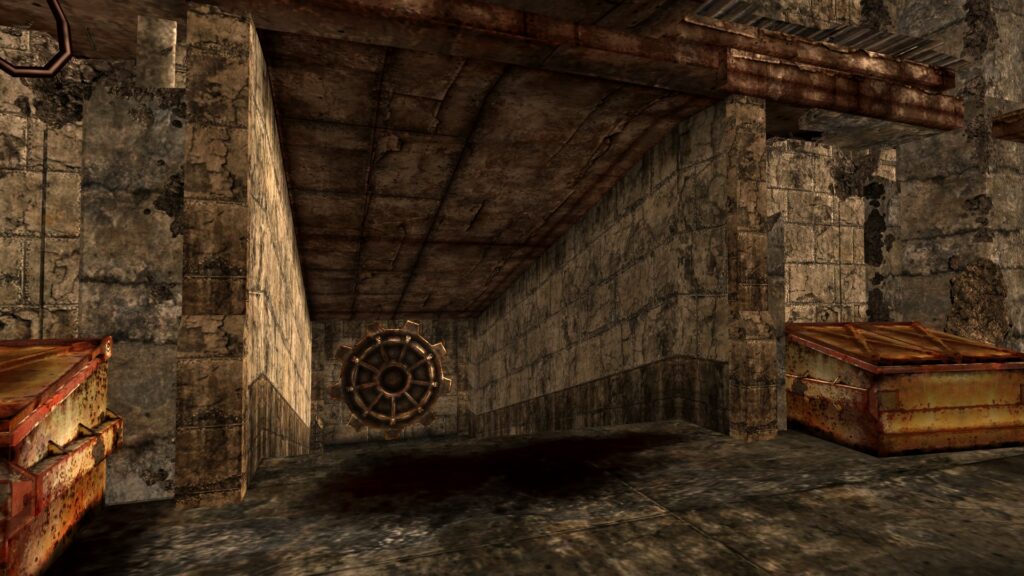
Vault 11:
Morality under pressure, leadership, willing and / or noble sacrifice for the greater good. Is a leader who willingly sacrifices him or herself for the greater good better or worse than a more self-centred individual? How do people react when forcibly put into a situation of having to sacrifice either themselves or others? Etc, etc.
Vault 22:
This is an interesting Vault in that it bears a certain resemblance to Fallout 3’s wacky science experiments stupidity… but actually has a damn good reason for it. The Vault experiment itself was self-sustainability; expedited growth of plants in order to feed a population over potentially decades or even centuries.
So why does it look like the Island of Doctor Moreau? Simple: because of the insane scientists at Big Mountain. Everything went wrong not because of the experiment itself, but because Vault 22 was co-opted as one of Big Mountain’s ‘test cities’, same as the Sierra Madre. Absent their meddling, the Vault experiment likely would have had drastically different results.
As with Vault 12, I’m happy to give this one a pass even if it wasn’t strictly a social experiment, simply because it still fits into the overall idea of going to space (fast growing plants would be vital on a generation ship, though they’d also have to figure out animal protein and fat, which are essential to human health).

See how New Vegas and Fallout 2 put the Vaults into a fairly background role rather than focusing on them super heavily? Because civilisation has moved on, developed, and stopped caring so much about the Vaults or the Pre-War world.
This is pretty much the whole theme of New Vegas, and was really brought to the fore in Dead Money: letting go of the mistakes of the Old World and building something new. Or, indeed, returning to the same Old World values that destroyed everything in the first place. There are plenty of examples of this theme in action, both in Dead Money itself, and the main game.
And Bethesda themselves unintentionally follow this theme in both Fallout 3 and 4; they’re unable to let go, clinging to the Old World and the ideas of the previous games, incapable of thinking up anything truly original or interesting themselves. Unable to simply let go and make something new.
Yeah, you could say the synths were something new (that don’t fit the universe of Fallout)… but really they were just a rehash of West World anyway. Tim Cain actually mentions in one of his videos that skeletal, Terminator-style endoskeleton robots were an idea someone came up with back in the day, and that he immediately shut it down as unworkable, because that style of robot doesn’t fit Fallout. This, more than anything else, really just shows how poorly Bethesda understands the IP they bought.
Then there are the power armour changes in Fallout 4. The first Iron Man movie was clearly the inspiration for that change. The Minutemen? Using something from hundreds of years ago instead of coming up with a new faction, as I did in my part on Eighton.
And before you mention the Legion, the whole point is to show that for all his grand ideas, Caesar is still just as attached to the Old World as every other faction (he’s utilising filthy Marxist Hagalian Dialectics, while the NCR is wedded to what amounts to Managed Democracy, and House is still a corporatist technocratic elite, all ideas that failed in spectacular fashion). Using something from the past in these cases had a purpose, and they were used to examine those philosophies and ideas. The Minutemen, on the other hand, say precisely nothing about anything, they’re nothing more than an aesthetic and a reference to Boston with no deeper meaning.
Having no deeper meaning is fine in the general sense, you don’t always need to have every single aspect of your work crammed with themes or moral messages or whatever. Creative people are inspired by all manner of things, it’s how creativity works (well… it was, until large language models and generative AI came along; those things will be the death of human creativity). But the important part is that you’re meant to do something new with it, or examine it in some way, or say something about it. Ideas are cheap, execution is what’s important, and Bethesda whiffs on that far more often than they succeed.
For example, the Institute. What exactly is this place meant to be about? What does it say? Other than the most basic bitch ‘slavery is wrong’ moral message smashed over your head like a sledgehammer, which is handled so ham-fistedly that I honestly believe ChatGPT could have written something more coherent and interesting, the Institute is about nothing. There is nothing there, no message, no theme, no ideas to explore. Just, ‘we’re making synths to redefine humanity, but we also treat them as chattel because we’re super smart science people!’
As Shamus Young said in Spoiler Warning’s Fallout 4 season: This is CHILDISH. And he’s 100% correct, it is indeed childish. Emil Pagliarulo can’t even be said to have an elementary school level understanding of the things he writes about… and yet he’s paid hundreds of thousands of dollars for it. *sigh* Anyway…

Now… we get to Fallout 3’s Vaults. And oh, deary me… still, at least Bethesda did manage to get a couple of them basically right, or… well, partly right? Maybe? They created a couple of Vaults that were basically sensible, at least.
There are all manner of depths you can plumb when it comes to social experiments of this nature, adding in the likes of radiation experimentation on the side, if we’re talking about sending people into space for extended periods of time, though those should always be very rare compared to the real meat of the matter; the social aspects of the project. Warning, incoming list:
Command ability; how well people take orders; teamwork; solo work; segregation; forced inclusion; racial diversity, homogenisation; putting people of radically different cultural backgrounds together; paranoia; superstition; extreme positivity; extreme negativity; extreme apathy; taking away all control and responsibility; overworking people; underworking people; selecting people with congenital diseases; designing a Vault with no crematorium facilities, introducing the issue of ‘disposal’…
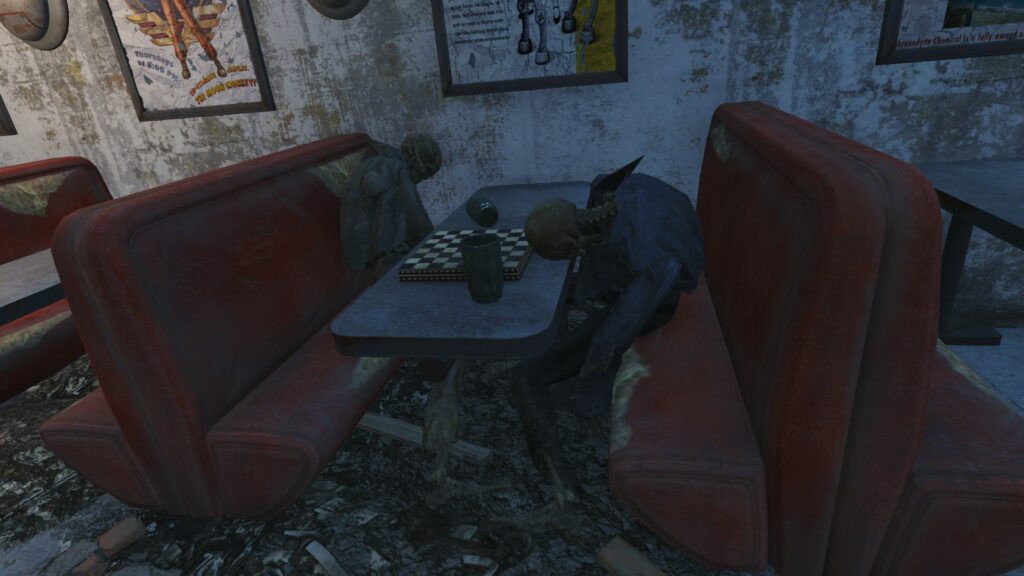
Food shortages (could be twinned with the issue of lacking a crematorium…); food overabundance; having all women; having all men; having all women and only one man; the reverse of the last one; solitude; constantly being surrounded by people; populating both male and female genders with nothing but gay / lesbian people; keeping men and women firmly apart except for purposes of breeding more people; intentionally faulty equipment designed to test ingenuity under pressure; hardware designed to break after x years, forcing Vault to open early.
And on and on and on. A lot of those I just listed off the top of my head have been explored in one way or another across the games (mostly outside of Fallout 3), and a few of them fall a little outside of being social experiments (like the faulty equipment one, which would still provide good data on how people improvise under difficult conditions), but there are still many left to explore and a variety of ways you could change things up by combining them or looking at them from slightly different angles.
So… that said, let’s see what Fallout 3’s writers came up with for this incredibly costly and time-consuming experiment…
Vault 92:
Super soldiers as a result of white noise? Um, okay? This one would’ve been a fine experiment if it had literally just been filling the Vault with nothing but musicians and artists, while simultaneously failing to have any physically capable labourers or cooks or cleaners or similar.
How do these people fare when faced with the reality of actually having to work instead of pursuing their creative muse? Do they get along? Do they attempt to delegate to lesser musicians they consider beneath their own ability? Do the pianists gang up on the violinists? But no. Super soldiers, because Bethesda.
To be clear, super soldiers themselves might well be useful in an off-world colony… if we didn’t already have power armour. Super soldiers are fiddly to create, unpredictable, and generally dangerous compared to just sticking a regular grunt inside a suit of damn near impregnable armour. A dinosaur-sized monster is about the only worry power armour has… and even then, you could probably just punch your way out of its stomach.
Vault 101:
Prolonged isolation. Sound familiar? It should, because—like most of this game’s entire plot—it’s basically just a rehash of events or places or things from the previous two games, made by infinitely more capable developers (recall my rant above, about doing something new with older ideas / inspirations? Yeah). Basically this is Vault 13 except without the water chip… oh wait, water comprises the whole main quest line, doesn’t it, and returning to Vault 101 later you find an unmarked quest involving… a broken water chip.
To be fair to Bethesda, they did at least mix things up a little bit by having this be an extended isolation experiment with an overseer who effectively ran a dictatorship the moment he got into power. It’s therefore not exactly identical to Vault 13 and potentially provides wildly different data. So yeah… a silver star to Bethesda for effort there. Doesn’t change all the other things they recycled more or less verbatim from Fallout 1 and 2, however.

Vault 106:
Psychoactive drugs released into the atmosphere for lulz. How exactly is this a social experiment? And how does the data retrieved from this wacky science hijinks benefit the project in any way? Admittedly, this is apparently something Bethesda took from the Fallout Bible, but eh, even the original creators aren’t perfect and occasionally came up with some strange ideas (talking Deathclaws, psychic mole rats, literal ghosts, etc.).
Now, if they’d instead given the Vault populace a massive cache of drugs with an open policy on indulging at will, that would’ve fit the experiment to a tee, as you’re then allowing the people themselves to decide how things go; that’s the whole point.
Would the Vault even survive if half the population are off their faces every day? Would they self-limit their use? Go wild with reckless abandon? Ration the drugs, thereby potentially creating a black market economy? Would a more relaxed (via drug use) population result in less friction? Or would withdrawal symptoms create tension and conflict? Would this result in the eventual birth of Mama Murphy?
All kinds of interesting ideas and possibilities arise as a result of an experiment like this. All it takes is a bunch of random people, a basement full of drugs, and some time. Pumping the drugs into the atmosphere completely undermines the entire concept of a social experiment.
Vault 108:
This is actually an excellent example, at least initially, of a Vault experiment done right, bravo whichever writer / designer at Beth came up with it. Having everyone there be afflicted with some form of congenital disease leads to the interesting scenario of social order in the face of utterly inevitable and early death.
How does this affect life in the Vault? Do the people with least life expectancy end up with the most dangerous jobs? Are the Vault’s resources diverted to trying to find cures? Do they think up crazy and implausible ideas in their futile attempts to stave off the inevitable? Or simply accept it and enjoy what life they do have? (There’s that ‘let go’ theme again…)
The introduction of a cloning facility kind of ruins things a bit, but it does at least leave the answers up to the people of the Vault itself, thereby avoiding false data resulting from outside interference. The Gary situation seems more like Bethesda being Bethesda and going for the ‘hilarious’ option instead of exploring something weightier, but the ingredients are certainly there for a well-thought-out Vault experiment.
And cloning could in fact be pretty useful in an off-world colony. Hell, that could have been a good Vault experiment all by itself; create an underpopulated Vault and stick a cloning machine in there, then see what happens, especially in the event you stock with it various types of DNA, not just human…
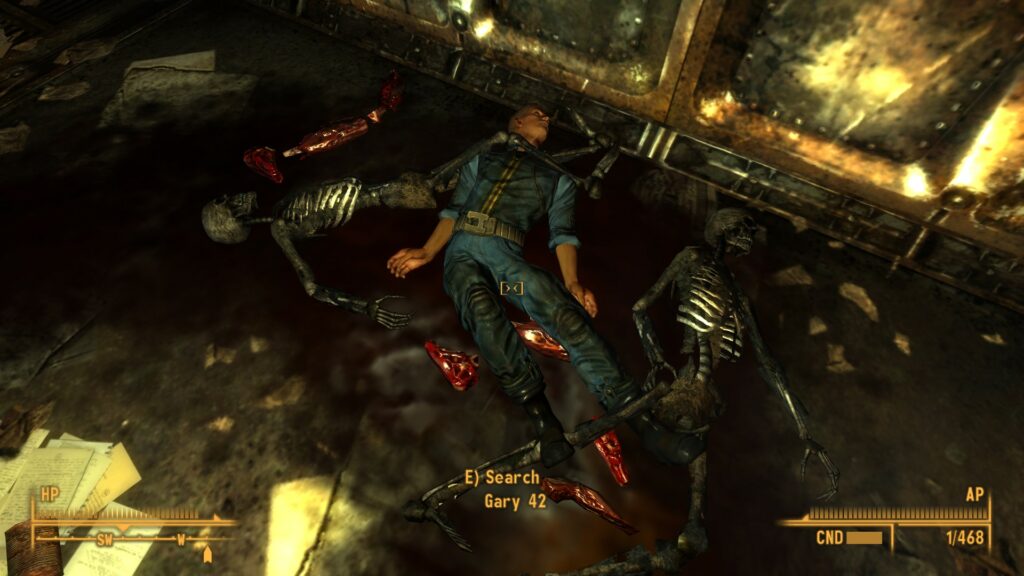
Vault 87:
I’ll cover this one in-depth later since it’s important for the Muties… but just know that I’ll be retconning the ever-living shit out of that place. By which I mean it won’t be a Vault any more.
Beyond that, again it’s not a social experiment, it’s ‘hilarious’ hijinks and Bethesda’s broken idea of SCIENCE! Effectively it’s only there to shoehorn in the Super Mutants, regardless of how much sense that makes (protip: it makes no sense at all, as the mutants and FEV itself were meant to be constrained to the west coast).
So… after being side-tracked by Bethesda’s general inability to grasp the purpose of the Vault experiments, it’s time to talk briefly about Vault 101 as a settlement. I have minimal beef with the place beyond it being boring as hell. Sure, you could argue that Vault 13 is pretty boring as well, but remember that you’re tossed out the front door and left to your own devices in the first game. You can go back inside to pick up a quest or two and some info on the Vault itself (for new players), but you’re not stuck in there for an entire hour before you even get to see the Wasteland. In Fallout 3, you are in fact stuck in a boring Vault for an hour.
Looking at each game, so far three of the five mainline titles have begun in a Vault, and the first game sidestepped the issue by actually having you begin outside the Vault; the overseer talking head simply tells you the water chip’s busted and you’re being sent to find a new one, at which point you’re dumped at the entrance to Vault 13 and expected to head out.
No tedious growing up section, no rose-tinted Pre-War section. Just you, your character, a simple objective, and a world to explore. And let’s be honest here, Fallout gets away with it simply because it’s the first game in the franchise and was therefore original and interesting by default.
Yes, the Vaults are important to the setting. But they’re not all there is, and should serve to inform and provide flavour, not be the primary focal point. Having the player start in relatively near vicinity to an abandoned Vault—something similar to Vault 15, for example—with some terminals and journals providing lore and backstory on the Vaults themselves would give the influx of new players a way to acclimate to part of the franchise’s lore while not forcefully stuffing it down their throats.
As they explore, they might find another one, potentially even the demonstration Vault in DC’s ruins, at which point the scope of the Vault project is revealed to be greater than the player might have imagined. You know, letting them learn about this aspect of the world at the same time as their character does? Yeah, that.
I get why Beth went with the Vault 101 start, of course, as I spoke about in the Vault 101 part. It’s easy, it introduces the player to the Vaults, and it shows how an operational Vault looks in readiness for showing the player the rusted, decaying carcass of a failed (uh, technically successful if we’re talking raw data) Vault later.
It provides a situation where the player’s avatar in the game world has as little idea about the world outside as the player will have. There are arguments to be made for both routes, but in this particular instance I’m actually on-board with Bethesda’s choice. It makes the most sense when taking an old property and giving it a fresh coat of paint for a new audience, so fair dues there.
Fallout 4, on the other hand… nope, I see zero reason to continue the trend of making the player a Vault dweller (we’ll talk a little bit about Fallout 4’s opening segment once we’re done with Fallout 3). And 76 naturally went the same route, because Bethesda can’t help themselves (yes, I know Bethesda themselves didn’t make that game, but they did oversee it… if you’ll excuse the pun).
I was going to add a little section at the end here on the G.E.C.K., and how Bethesda managed to get that wrong as well, but since this part is already pushing 3,400 words, I’ve split that section out for the next part.
If you enjoy my work, consider buying me a coffee, or jump onto my newsletter to receive updates, free chapters, stories, and other goodies.


